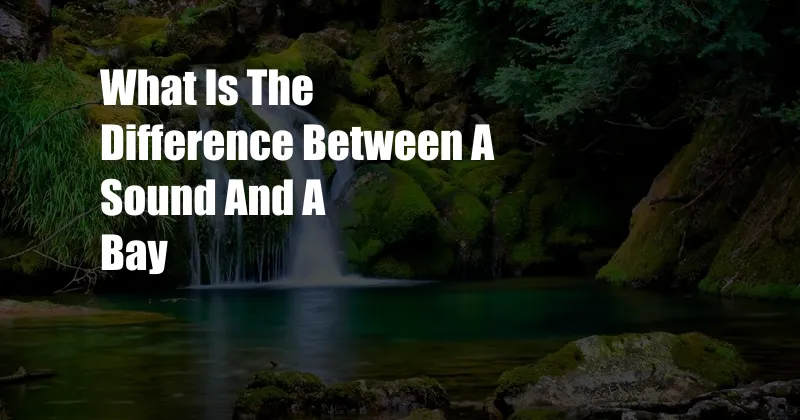
The Curious Case of Sounds and Bays: Exploring the Intricate Dynamics of Coastal Geography
Ever since I embarked on my journey to explore the enigmatic realms of coastal landscapes, I’ve become captivated by the subtle nuances that distinguish bodies of water. The majestic bodies of water known as sounds and bays allure me with their contrasting features and ecological significance. Let’s dive into the depths of this multifaceted topic to unravel the captivating differences between these maritime wonders.
Sound or Bay: A Tale of Two Territories
A sound is essentially a coastal body of water that is partially enclosed by land but remains connected to the open ocean. Sounds often form along elongated stretches of coastline, typically at the mouths of large rivers or valleys. They serve as crucial waterways for marine transportation and offer sheltered harbors for vessels during inclement weather. One striking example is the Puget Sound in Washington State, famed for its picturesque islands and diverse marine life.
Bays, on the other hand, are also coastal bodies of water, but they are more enclosed than sounds, with a narrower opening to the open ocean. Bays can be formed by various mechanisms, including the erosion of landmasses by waves, the deposition of sediment by rivers, or the volcanic activity that creates calderas. Chesapeake Bay on the eastern coast of the United States is a vast and ecologically rich example of a bay.
A Journey into the Depths of Sounds and Bays
Definition: Sounds are partially enclosed bodies of water connected to the open ocean, while bays are more enclosed bodies of water with narrower openings to the ocean.
History: Sounds and bays have played significant roles throughout history, serving as important routes for exploration, trade, and military expeditions. They have witnessed the rise and fall of civilizations and have been the stage for countless maritime adventures.
Meaning: Both sounds and bays serve as vital ecosystems, supporting a wide variety of marine species. They provide essential habitats for fish, shellfish, seabirds, and other organisms, contributing to the overall health and productivity of coastal environments.
Unraveling the Complexities of Sounds and Bays
Sounds are often characterized by their intricate network of waterways, inlets, and islands. Due to their sheltered nature, sounds provide a haven for recreational activities such as boating, fishing, and kayaking. They often boast stunning landscapes, with towering cliffs, verdant forests, and sandy beaches.
Bays, with their more enclosed nature, typically offer calmer waters and more protected conditions for marine life. They serve as significant breeding grounds for fish and shellfish, making them vital for commercial and recreational fisheries. Bays also play a crucial role in regulating coastal water quality by acting as natural filters for pollutants.
Navigating the Latest Trends and Developments
Recent advancements in technology have allowed for a deeper understanding of the dynamics of sounds and bays. Remote sensing and satellite imagery provide valuable data on water quality, currents, and sediment transport, helping researchers and policymakers manage these ecosystems sustainably.
The conservation of sounds and bays is of utmost importance, as they face various threats such as pollution, habitat loss, and overfishing. Many organizations and government agencies are implementing initiatives to protect and restore these vital coastal ecosystems for future generations.
Expert Advice and Tips for Bay and Sound Explorers
-
Explore with Respect: Always remember that sounds and bays are delicate ecosystems. Practice responsible boating, fishing, and swimming to minimize your impact on these fragile environments.
-
Observe and Learn: Take the time to observe the intricate dynamics of sounds and bays. Note the different types of marine life, observe the changing tides, and appreciate the unique beauty of these coastal wonders.
-
Support Conservation Efforts: Engage with local organizations and initiatives working to conserve and protect sounds and bays. Your involvement can make a tangible difference in preserving these precious ecosystems.
Frequently Asked Questions
-
Q: What is the difference between a sound and a bay?
A: Sounds are partially enclosed bodies of water connected to the open ocean, while bays are more enclosed bodies of water with narrower openings to the ocean. -
Q: Why are sounds and bays important?
A: Sounds and bays are vital ecosystems that provide habitats for diverse marine life, support commercial and recreational fisheries, and regulate coastal water quality. -
Q: How can I help protect sounds and bays?
A: Practice responsible boating and fishing, observe wildlife respectfully, support conservation efforts, and reduce your carbon footprint.
Conclusion
The labyrinthine world of sounds and bays captivates with its intricate landscapes, ecological significance, and historical allure. Understanding the subtle differences between these coastal realms enriches our appreciation of the intricate tapestry of the natural world. Whether you’re an avid mariner, a coastal explorer, or simply someone curious about the wonders of our planet, I invite you to delve deeper into the fascinating realm of sounds and bays, uncovering the hidden treasures that await discovery beneath the shimmering surface of the sea.